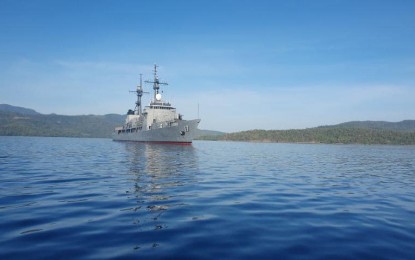
BACK IN ACTION. The BRP Andres Bonifacio (PS-17), one of the Philippine Navy's three offshore patrol vessels, in this undated photo. The ship is back to patrol duties after a significant upgrade in its combat management system and search radar. (Photo courtesy of BRP Andres Bonifacio)
MANILA – The BRP Andres Bonifacio (PS-17), one of the Philippine Navy (PN)'s three offshore patrol vessels, is back to its patrol duties after an intensive upgrade of its communications and sensor equipment.
"Following the successful completion of its extensive upgrades, Philippine Navy patrol ship BRP Andres Bonifacio is back in action, resuming its naval operations with upgraded capability within the Naval Forces West and AFP (Armed Forces of the Philippines) Western Command area of operations," read the ship's Facebook post on Monday.
The works included a significant upgrade in combat management system, the central nervous system that integrates various sensors and systems to provide real-time situational awareness, command, and control capabilities.
"It was also fitted with air and surface search radar, bolstering its capability in long-range surveillance, search and rescue, and maritime patrol," the post added.
No other details were provided due to security reasons.
The upgrades reflected the vessel’s optimum operational readiness, emulating its motto “Semper Paratus” (Always Ready).
"With enhanced systems and advancing capability, PS-17 is poised to better fulfill its mandates under the Naval Task Force 41 from maritime patrol operations, to internal security operations, and to logistics support missions," it said.
Beefing up capabilities
The AFP, meanwhile, would focus on five major defensive capabilities as it adopts the Comprehensive Archipelagic Defense Concept (CADC), aimed at defending all the country's territories, including its exclusive economic zone (EEZ).
The five focus areas are cyber systems, air interdiction, surface and sub-surface, missile defense systems, and support systems capabilities.
This was discussed during the National Security Cluster Communications of the "Bagong Pilipinas" Media Engagement and Workshop held at the Philippine Merchant Marine Academy in San Narciso, Zambales on May 2 to 4.
All the improvements are part of the AFP Modernization Program Re-Horizon 3.
To ensure that it is capable of conducting this mission, the AFP needs adequate radar coverage to detect and identify intrusions in Philippine territory; air and maritime assets with adequate defensive capabilities; cyber defensive capabilities to defend against opponents looking to attack cyber infrastructures; and missile systems to defend critical infrastructures.
Also needed are credible and capable land maneuver forces for both conventional and asymmetric warfare, credible reserve forces and logistics support systems.
Defense Secretary Gilberto Teodoro Jr. earlier said the CADC will allow the AFP to protect and guarantee "Philippine nationals, Philippine corporations, and those authorized by the Philippine government the unimpeded and peaceful exploration and exploitation of all natural resources within our EEZ and other areas we have jurisdiction." (PNA)
